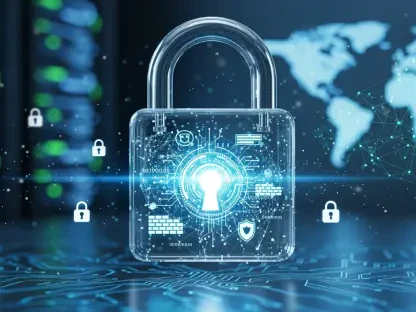In an era where cyber threats are continuously evolving, banks need robust strategies to enhance their cyber resilience. This involves a comprehensive approach encompassing governance, risk management, incident response, and third-party risk management. Banks face mounting pressure to adopt these strategies due to the relentless surge in cyberattacks targeting financial institutions. Regulatory bodies have also been tightening requirements to ensure that these institutions maintain a high level of security, making the enhancement of cyber resilience not just a necessity, but a critical priority for survival and trust in the industry.
Foundations of Cyber Resilience
Governance, Risk, and Compliance (GRC)
A solid Governance, Risk, and Compliance (GRC) program is the bedrock of cyber resilience in banking. It lays down the necessary framework for risk management practices, ensuring that banks have a fault-tolerant security infrastructure. By encompassing policy formulation, process improvement, and adherence to regulatory requirements, GRC programs foster a structured approach to identifying, assessing, and mitigating risks. This is especially vital in the banking sector, where the complexity and sensitivity of transactions necessitate meticulous oversight and robust protection mechanisms.
The significance of a well-established GRC framework cannot be overstated when considering the intricate nature of financial operations that span multiple jurisdictions and regulatory landscapes. Robust risk management practices within this framework involve regular risk assessments and implementation of controls to address identified vulnerabilities. By doing so, banks can preemptively address potential security gaps that could be exploited by cyber adversaries. Furthermore, integrating compliance management within the GRC framework ensures that banks not only meet regulatory mandates but also enhance their overall security posture, thereby instilling confidence among stakeholders and customers.
Incident Response and Vulnerability Management
Strong incident response capabilities and regularly tested disaster recovery plans are vital for ensuring that banks can swiftly handle cyber incidents and minimize impact. These response mechanisms are constructed to address various stages of a cyberattack, from detection and containment to eradication and recovery, offering a comprehensive defense against potential damage. Equipping incident response teams with the right tools, clear playbooks, and continuous training significantly enhances their ability to respond promptly and effectively to threats, thereby minimizing downtime and financial loss.
Effective vulnerability management plays an equally important role in fortifying security by anticipating and mitigating potential threats. This process involves regular scanning of systems, identifying vulnerabilities, and applying patches or fixes to prevent exploitation. By maintaining an up-to-date vulnerability database and encouraging a culture of proactive security measures, banks can reduce risk exposures and bolster their defenses. Moreover, conducting frequent security assessments and red team exercises helps simulate real-world attack scenarios, providing valuable insights for strengthening the overall cyber resilience strategy.
Leveraging Established Frameworks
NIST Cybersecurity Framework
Adhering to the NIST Cybersecurity Framework is crucial for continuous improvement, providing a structured approach to assess and enhance security controls. This framework is designed to help organizations of all sizes understand, manage, and reduce their cybersecurity risks. By adopting its core functions—Identify, Protect, Detect, Respond, and Recover—banks can comprehensively cover all aspects of cybersecurity, ensuring a robust and holistic defense strategy. The NIST framework also encourages organizations to tailor their security controls based on specific risks and regulatory landscapes they operate within.
The emphasis on continuous improvement within the NIST Cybersecurity Framework ensures that banks remain adaptable and prepared for emerging threats. Regularly updating security controls, conducting risk assessments, and leveraging the framework’s tiers and profiles, which offer a customizable approach, enable organizations to maintain an agile and dynamic cybersecurity program. This adaptability is vital in an environment where cyber threats and technologies are rapidly evolving. The framework’s structured approach to enhancing overall resilience ensures that banks can effectively deter, withstand, and recover from cyber incidents, thereby safeguarding their assets and maintaining customer trust.
Identity and Access Management (IAM)
Identity and Access Management (IAM) is now considered the new firewall, providing secure and modernized identity practices that ensure sensitive data is protected. Implementing IAM solutions allows banks to manage user identities and control access to critical systems and data effectively. This includes mechanisms for authentication, authorization, and auditing, all of which are essential for preventing unauthorized access and managing user privileges. The adoption of technologies such as multi-factor authentication, single sign-on, and role-based access control further enhances security by adding layers of protection.
Secure IAM practices help banks to strengthen their cyber resilience by minimizing the risk of insider threats and reducing the attack surface. By maintaining rigorous authentication protocols and promptly revoking access for terminated or non-compliant users, banks can significantly limit the potential for data breaches. Additionally, modernizing IAM systems with advanced analytics and machine learning enables real-time monitoring and detection of anomalous activities, allowing for swift preemptive actions. Integrating IAM into the broader cybersecurity strategy ensures comprehensive protection for sensitive information and aligns with best practices for data security and regulatory compliance.
Challenges and Solutions in Incident Response
Common Pitfalls
Assumptions about the state of organizational platforms and outdated playbooks can lead to ineffective incident response, hampering a bank’s ability to mitigate and recover from cyberattacks. This complacency often results in unpreparedness when an actual incident occurs, leaving institutions vulnerable to significant financial and reputational damage. Regularly reviewing and updating incident response plans is essential to keep pace with the rapidly changing threat landscape. Ensuring that all team members are aware of and trained on the latest protocols can prevent missteps and enhance overall response effectiveness.
Banks must invest in ongoing training and simulation exercises to ensure readiness. Outdated playbooks may not account for new types of cyber threats, which are continuously evolving. Keeping incident response strategies current requires collaboration across departments, including IT, legal, and risk management teams, to incorporate a wide range of perspectives and expertise. This comprehensive approach ensures that the organization can respond cohesively and adapt to emerging threats, maintaining operational continuity while minimizing harm.
The Human Element
The effectiveness of incident response heavily relies on top talent, requiring banks to invest in skilled personnel who are adept at handling sophisticated cyber threats. Talented cybersecurity professionals bring not only technical expertise but also the ability to think critically and adapt quickly in high-pressure situations. By fostering a culture of continuous learning and professional development, banks can retain these valuable team members and ensure they remain at the forefront of security practices. This investment in human capital is a key differentiator in maintaining an agile and effective incident response.
Developing effective communication plans and connectivity to core functions like risk, legal, and compliance is crucial for a streamlined incident response. Clear lines of communication and well-defined roles enhance coordination and ensure that all necessary actions are taken swiftly and efficiently. By integrating incident response with these core functions, banks can address legal implications, manage risk exposure, and comply with regulatory requirements in a cohesive manner. This not only reduces the impact of incidents but also demonstrates a commitment to comprehensive security management to stakeholders and regulators.
Addressing Third-Party Risks
Supply Chain Cyber Threats
Managing third-party risks requires continuous monitoring and improvement, especially as supply chains become increasingly complex and interconnected. Contractual safeguards, such as right-to-audit clauses and service level agreements, are essential to ensuring that vendors maintain adequate security measures. These clauses provide banks with the authority to assess and verify the security practices of their third-party partners, ensuring compliance with established standards. Additionally, maintaining regular communication and collaboration with vendors helps to align security strategies and address any potential vulnerabilities systematically.
Effective supply chain risk management necessitates a thorough understanding of each vendor’s security posture and practices. This requires conducting comprehensive due diligence and contextualized security reviews based on risk levels and threat intelligence. By evaluating the specific risks associated with each vendor and tailoring security requirements accordingly, banks can mitigate the potential impact of third-party vulnerabilities. Treating vendors as extensions of the bank’s network and maintaining heightened awareness helps to ensure that all parties are aligned in their commitment to maintaining robust cyber defenses.
Due Diligence and Security Reviews
Banks must conduct thorough due diligence and contextualized security reviews based on risk levels and threat intelligence to effectively manage third-party risks. This involves a multi-faceted approach that includes initial vendor assessments, ongoing monitoring, and regular audits to verify compliance with security standards. By leveraging threat intelligence, banks can stay informed about emerging risks and adjust their security strategies to mitigate potential threats. Conducting these reviews also provides valuable insights into areas where vendors may need to improve, facilitating collaborative efforts to enhance overall security.
Engaging in continuous monitoring and improvement practices is essential for maintaining the security of third-party relationships. This includes establishing clear expectations and performance metrics for vendors, conducting regular compliance checks, and fostering open communication channels. Ensuring that vendors adhere to the same high standards of cyber resilience as the bank itself helps to create a cohesive and secure supply chain ecosystem. By prioritizing due diligence and security reviews, banks can safeguard their operations against external threats and maintain the trust of their customers and stakeholders.
Executive Focus on Data Protection
Core Mission for Banking Executives
Data protection should be a core mission for banking executives, as it is fundamental to safeguarding sensitive information and maintaining customer trust. Implementing strong data protection safeguards across the entire data lifecycle is crucial to prevent data breaches and mitigate the impact of any unauthorized access. This involves not only securing data at rest and in transit but also ensuring that data is appropriately classified, encrypted, and monitored. Developing a data protection strategy that encompasses these elements helps to create a robust defense against potential threats.
Executive leadership plays a pivotal role in fostering a culture of security within the organization, setting the tone for proactive and vigilant data protection practices. By making data protection a strategic priority, banking executives can allocate necessary resources, champion security initiatives, and ensure that all employees are aware of and adhere to security policies. This top-down approach reinforces the importance of data security and aligns the entire organization towards a common goal of safeguarding customer information and maintaining compliance with regulatory requirements.
Strategic Investment
In today’s world, where cyber threats are constantly evolving, banks must adopt robust strategies to bolster their cyber resilience. A thorough approach is necessary, which includes governance, risk management, incident response, and overseeing third-party risks. The relentless surge in cyberattacks on financial institutions has increased the urgency for banks to adopt these strategies. Regulatory bodies are also ramping up their requirements, ensuring institutions maintain stringent security measures. This makes enhancing cyber resilience not merely necessary but a critical priority for the survival and trustworthiness of the banking industry. Banks that fail to adapt may find themselves at significant risk, undermining customer trust and regulatory compliance. Therefore, the focus on strong cybersecurity is not just about meeting standards but fundamentally about ensuring the safety and security pivotal for ongoing operations and customer trust.









